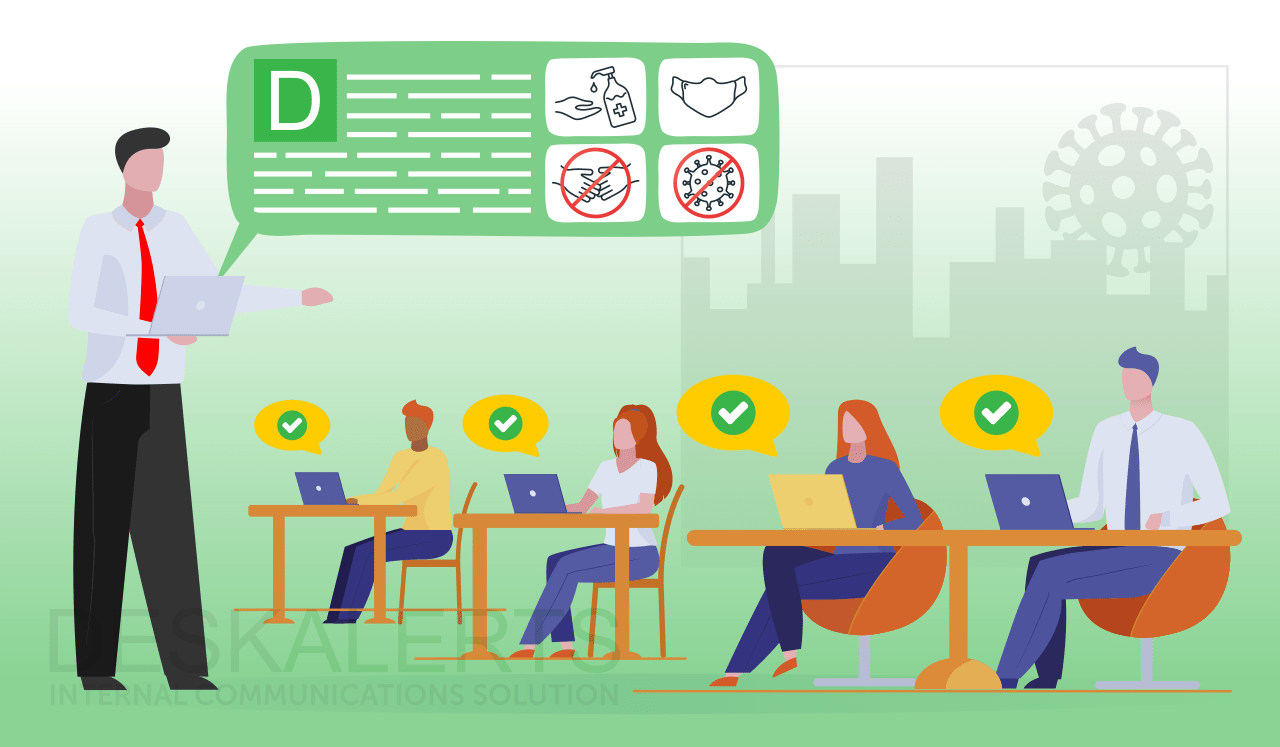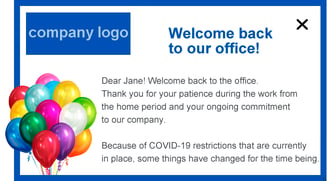
As COVID-19 restrictions have changed in some parts of the world, some employees who have been working from home during lockdowns are starting to return to the workplace.
Notwithstanding that the Delta variant has been causing havoc and delaying some companies’ plans to return to the office, many are planning ahead for when the time will come to transition back to the workplace. While there is continuing uncertainty, even with vaccines now available, one thing that is certain is that the workplace we knew and left behind in early 2020 won’t be the same one that most workers find themselves returning to.
When you’re making plans to transition your workforce back to the workplace after a coronavirus outbreak, in addition to having a return to work plan, you should also have a return to work letter that you can disseminate to all employees so they can understand what is required of them, and what support and assistance they will be given, as they navigate the “new normal” of life in the workplace.
Table of contents
How to create your return to work letter (and a template)
How to communicate your welcome back to work letter
Choosing the right time to return to the office
What to do if employees refuse to return to the workplace
Should I complete new hire paperwork when workers return to the office?
How to deal with employee turnover following a COVID-19 outbreak
How are companies planning to return to the office post-COVID-19?
Return to work letter from employer to employee (sample)

To help you to welcome your employees back to work following COVID-19, we’ve prepared a free return to work letter template to make it easier. Fill in and adapt our return to work sample letter so that it is relevant to your organization, and then circulate it to your employees.
You can access the sample return to work letter from employers to employees here.

How to create your return to work letter (and a template)
Transitioning your employees to working from the office means you need to ensure they are healthy and safe. Your return to work letter from employer to employees should cover off the following information:
1. Welcoming your employees back
Whether all your employees are returning, or just some of your employees, you should warmly welcome them back. Do not forget to create the back to work letter template in advance.
2. Outline any changes made to the work environment
Every workplace is different, depending on the industry you’re in, your physical facilities, government regulations, and the roles that your employees work in.
As you will see in our sample letter for return to work after COVID-19, you should let your employees know what changes have been made to comply with social distancing and other hygiene measures:
- Have desks been moved?
- Is there more cleaning?
- Can they use shared spaces as they could previously or are these areas now off-limits?
3. What PPE do your employees need to use?
Again, this will vary from company to company and even from role to role. At the very minimum, your employees will need to wash their hands with soap and use hand sanitizers regularly. Some may need to wear a mask or other face coverings. The types of face coverings may vary depending on their role and the contact they have with others.
Other PPE such as face shields, gowns, and gloves may be required depending on the work your employees do. That’s why mail for rejoining after lockdown is important - these safety measures are too important to be overlooked.
>> Learn more about face mask policy for employees<<
4. What do your employees need to do?
The return back to work letter after COVID-19 should outline whatever steps you require your employees to take each day to ensure that they are safe and that their colleagues and your customers are safe.
This includes:
- outlining proper handwashing techniques,
- when to use hand sanitizer,
- what to do if they cough or sneeze,
- how to wear a mask,
- how to wear any other PPE that you require of them.
In the return to work letter, provide information to employees about what they should do if they display symptoms, are diagnosed with COVID-19, or come into contact with a confirmed case of COVID-19. This includes what types of leave may be available to them in the event of sickness or having to quarantine.
5. Where can employees get more information?
The return to work letter should direct your employees to where they may find more information. For example, you may have a dedicated space on your corporate intranet site with all your COVID-19 related HR policies or they may need to contact someone in HR for more specific advice. This should include health and safety information and any services your organization provides such as mental health counseling.
6. Let your employees know how often you will update them
Good communication is essential in a crisis. Your rejoining letter after lockdown should let your employees know how often they can expect to hear from management as the situation changes. For example, will there be a weekly update or will you inform them periodically as needed, such as if there is a positive COVID-19 case in the company or if social distancing measures are relaxed or ramped up again? Also, let your employees know how this information will be communicated with them.
7. Thank your employees for their efforts
Your employees are going through a lot right now. Your return to work sample letter should thank them for their continued efforts to keep your company operating both now and into the future. Continuing to establish and nourish interpersonal relationships between managers and employees is very important.

How to communicate your welcome back to work letter
There are different ways you can communicate the back to work letter to your employees: you could send it via email, send it via a pop-up alert or scrolling desktop ticker with a link to click for more information in DeskAlerts, place it on your corporate intranet site or publicize it on other platforms like Yammer or Slack.
If you use DeskAlerts, you can select a target audience and send it to only the employees your letter is relevant to – so if all your employees are returning you can send it to everyone. But if it is only some employees, simply send the return to work letter to the ones who need to see it.
You should send your welcome back letter to arrive at a time when your employees will see it on return to the office - scheduling in advance will help you to get the timing right so they don’t miss it.
Choosing the right time to return to the office
The COVID-19 situation is constantly evolving. Some countries have now experienced several waves of the pandemic, while others are almost back to business as usual. It’s important that you are vigilant and follow all the correct advice from your local government authorities when determining when it is safe for your employees to return, keeping in mind that it might be illegal to require them to physically attend the office if there are work from home or shelter in place mandates in place.
Other factors to consider include:
- Vaccination – will you be requiring your employees to have a mandatory vaccine before they return to the office? If so, what do the vaccination schedule and waiting list look like where you are? In some countries, there is limited access to vaccine supplies and it might take several years to vaccinate the entire population. It is also becoming evident that booster shots will be required on an ongoing basis.
- Whether employees are required back or not – you may have found that there are some roles that can continue to work from home for a while longer and this might be something that you factor into the decision to transition the workforce back to the office. After all, the fewer people in the office, the safer it is.
- Whether you will take a new approach to flexibility – in some places, the office as we knew it is now completely dead and employees are going to be able to work remotely indefinitely. In other companies where employees are returning to a “new normal” there is now more consideration being given to flexible working arrangements and a hybrid model (for example, a few days at home, a few days in the office each week).
- What to do if employees refuse to return to the workplace – depending on your jurisdiction, employees can have disciplinary action taken against them if they fail to comply with a reasonable workplace directive. However, there might need to be some leeway: some employees may have legitimate health and safety concerns that you need to address.
You may want to include all these considerations and adjust the return to work letter sample accordingly.
What to do if employees refuse to return to the workplace
Depending on your jurisdiction, employees can have disciplinary action taken against them if they fail to comply with a reasonable workplace directive.
However, there might need to be some leeway: some employees may have legitimate health and safety concerns that you need to address or have caring responsibilities. Offering flexibility is key.
There are some best practice steps you should take in order to protect the company, however. This includes:
- Writing a return to work notice to the employee.
- Documenting whether or not the employee rejected this offer - you should ask for it also in writing.
- Informing your state unemployment insurance office (if you are in the United States) within 30 days advising them that your employee has rejected the reemployment offer.
Should I complete new hire paperwork when workers return to the office?
Whether or not you need to complete new hire paperwork for employees will depend on a range of factors, including the law where your business is located.
In some cases, if the time employees spent away from the workplace was because of a furlough, and wasn’t a layoff, you would not be expected to complete new hire paperwork as their continued employment status is assumed.
You should still ensure you document the dates of the furlough on the employee’s personnel file while also sending a rejoining letter after COVID-19 leave.
In other locations, a lengthy furlough might be considered to be a separation from employment. It’s important you check with your local authorities to determine what paperwork you need to file.
In either case, it is important to send an official joining letter after COVID-19 to the employee outlining their status.
How to deal with employee turnover following a COVID-19 outbreak
The COVID-19 pandemic has caused high rates of turnover and absenteeism in many industries, for a range of reasons… and this is expected to continue as employees who have enjoyed the work/life balance benefits of working from home are made to return to the office.
There are several strategies that you can implement to help reduce employee turnover. These include:
- Continuing to provide remote working or hybrid working potions.
- Expand your employee assistance programs to help employees with any burnout or mental health issues.
- Give employees a pay rise or other benefits and bonuses.
How are companies planning to return to the office post-COVID-19?
According to a recent survey from Deloitte, 64% of business executives surveyed expect their companies will return to the office at some point this year, while another quarter of respondents indicated that they had already returned to the office.
Different corporations are taking different approaches. Tech giants like Facebook and Upwork have said that the days of working primarily from the office are over for their staff.
Other companies are requiring that their employees still go to the office at least some of the time - one of the most common splits seems to be 60/40 between work and home.
Many companies are mandating vaccines for employees before they return to the workplace. This is a developing issue that will no doubt continue to have ramifications for the industry in the future, as many people are opposed to being vaccinated.
Of course, there are industries that cannot function remotely at all, and these have been changed throughout the pandemic with staffing quotas changing, social distancing measures, increased use of PPE and more.
***
Creating a safe workplace is important and welcome back letters to staff are a great way to let them know what measures are being implemented will not only help to keep the workplace safe but will also help to ensure your employees feel safe and have higher levels of morale and engagement, which is why you should ensure you keep them in the loop at all times, especially when they return to the workplace after a period of uncertainty. Don’t forget to download our sample return to work letter from employers to employees to assist with your communication.
 Caroline Duncan
Caroline Duncan










